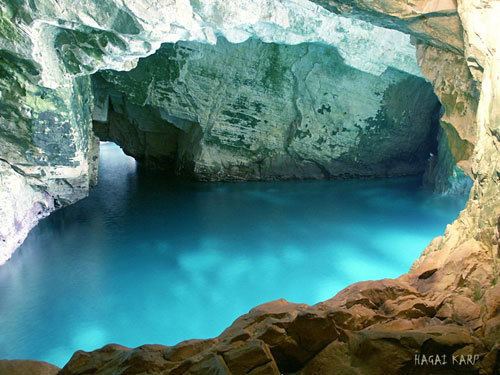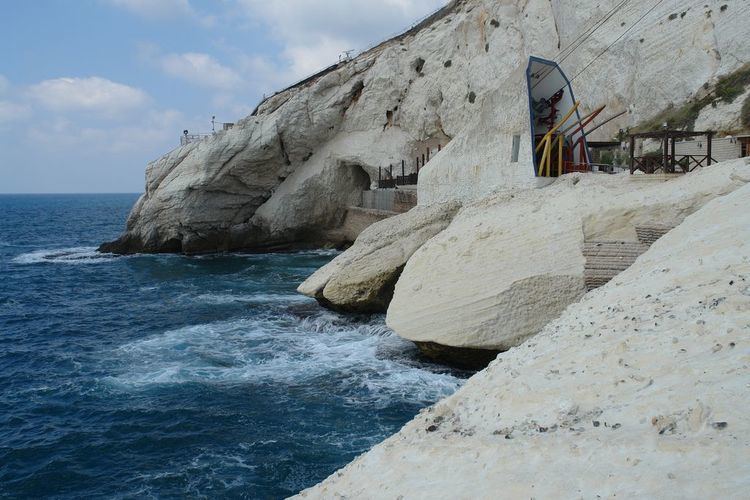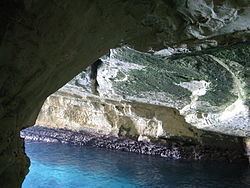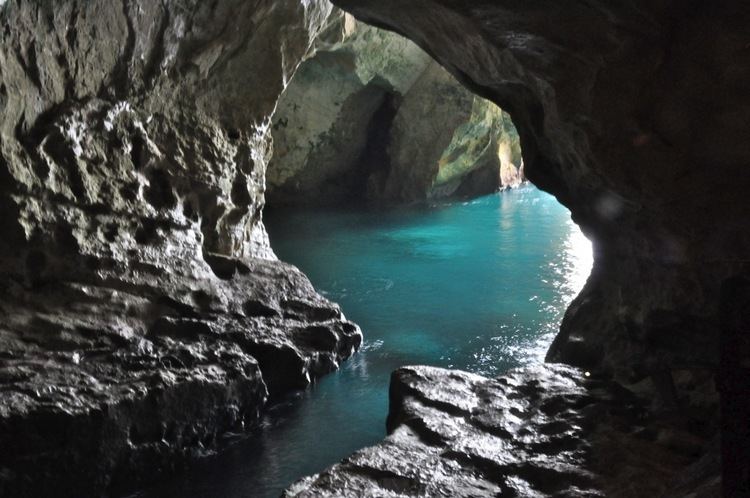 | ||
Similar Achziv, Montfort Castle, Ein Gedi, Banias, Beit She'arim National | ||
Rosh hanikra grottoes israel
Rosh HaNikra or Hanikra (Hebrew: ראש הנקרה, lit. "Head of the Grottoes"; Arabic: رأس الناقورة, Ras an-Nakura) is a geologic formation in Israel, located on the coast of the Mediterranean Sea, in the Western Galilee. It is a white chalk cliff face which opens up into spectacular grottos.
Contents
- Rosh hanikra grottoes israel
- Explore the beautiful rosh hanikra grottoes
- History
- Nature reserves and national park
- Cable car
- References

The Rosh HaNikra grottoes are cavernous tunnels formed by sea action on the soft chalk rock. The total length is some 200 meters. They branch off in various directions with some interconnecting segments. A tunnel was built during the Second World War for the Haifa-Beirut railroad line, and in 1968 a second one was dug, both connecting the grottoes with each other and allowing access (currently: only exit) along the former route of the WWII railroad. For many years though, the only access to the grottoes was from the sea and experienced swimmers and divers were the only ones capable of visiting. The 400 meters long tunnel dug in 1968 between the grottoes and slightly above sea level improved the situation, and soon after a cable car was built to take visitors down from the top of the cliff to the tunnels. With a 60-degree gradient, this cable car is advertised as the steepest in the world.

A kibbutz, also named Rosh HaNikra, is located nearby. The Israeli city Nahariya is located about 10 km (6 miles) south of Rosh HaNikra.

Explore the beautiful rosh hanikra grottoes
History

The Book of Joshua mentions "Misraphot Mayim" as a place south of Rosh HaNikra that was the border of the Israelite tribes of the time. In the Book of the Maccabees, it is referred to as the place that Shimon HaHashmonai was responsible for in 144BCE (1 Maccabees 11:59). Josephus Flavius also describes Rosh Hanikra as the northern border of the city of Acre, Israel. (The Jewish War 2, 10, 2). The archaeological tell is today situated within the kibbutz.

In the Jewish apocryphal First Book of Maccabees (1 Macc 11:59), a cape in this region is referred to as "The Ladder of Tyre" (Hebrew: sullam Tzor; Greek: ̔Η κλίμαξ Τύρου, He klimax (apo tes klimakos) Turou); the author could have meant either the cliffs at Rosh HaNikra, or one of two other capes jutting out into the sea slightly north or south of them. The site was later named an-Nawakir ("The Grottoes") by the Arabs.

Rosh HaNikra has served as a passage point for trade caravans and armies between Lebanon, Syria, Israel, Egypt, and Africa. During the Second World War, South African forces blasted railway tunnels through the nearby rocks for trains running along the Cairo-Istanbul line. The railway bridge at Rosh HaNikra was spared by the Haganah during the 1946 Night of the Bridges operation but, following a late-1947 British announcement that it would withdraw from Palestine months ahead of schedule, the bridge was destroyed by the 21st Battalion under the Palmach in late February 1948 to hinder Lebanese arms shipments to Arab forces opposing the UN Partition Plan. As repairs were prohibitively expensive, the tunnels were later completely sealed. The Lebanese railways have been largely dismantled while the Coastal Railway in Israel currently ends near Nahariya, several kilometers to the south.
Rosh Hanikra was the location where Israeli and Lebanese officials negotiated and concluded an armistice agreement in 1949 which ended the Lebanese-Israeli component of the 1948 War of Israeli Independence. A border passage across the Blue Line into Lebanon at the site is sometimes used by UNIFIL personnel.
Nature reserves and national park
The area around Rosh HaNikra includes a number of nature reserves:
The Rosh HaNikra national park also has jurisdiction of 220 dunams in the area.
Cable car
The Rosh HaNikra cable car is a cable car serving tourists wishing to visit the grottoes The Cable car is situated very close to the Lebanese border. The site is popular with tourists, and is one of the facilities available for tourists in Kibbutz Rosh HaNikra. The cable car was manufactured by Austrian manufacturer Doppelmayr Garaventa Group, and claims to be the steepest cable car in the world, ascending at a gradient of 60 degrees. Inasmuch as its lower base station is located on the sea, the cable car is occasionally affected by stormy weather.
